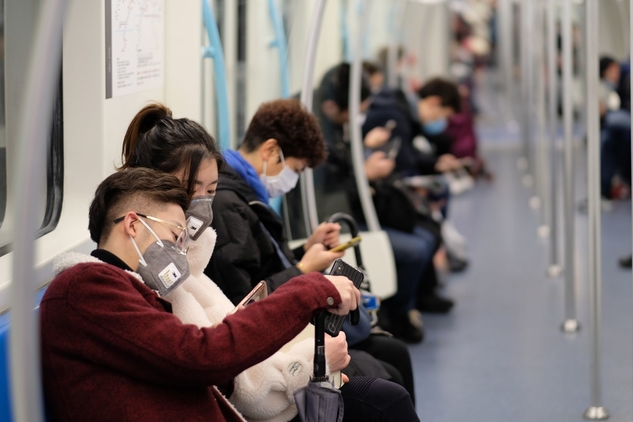Beware of Asymptomatic Patients Without Fever and Cough
University of Hong Kong Warning: Wuhan Coronavirus Epidemic to Spread Until May

Source:Shutterstock
Chair of Infectious Diseases at the University of Hong Kong Yuen Kwok-yung, who played a key role in containing the SARS outbreak in 2003, warned that probably half of all people who contract the novel coronavirus remain asymptomatic, not showing any signs of fever or cough although they suffer from pneumonia.
Views
University of Hong Kong Warning: Wuhan Coronavirus Epidemic to Spread Until May
By Sydney Pengweb only
As the Wuhan coronavirus, also known as 2019-nCoV, continues to spread in China and across its borders, attention is focused on measures to contain the outbreak. The WHO Collaborating Centre for Infectious Disease Epidemiology and Control at the University of Hong Kong, which is in constant contact with Chinese authorities, predicted in two press conferences after the Lunar New Year that the outbreak, estimated to have infected more than 40,000 people so far, will continue a few months to peak in April or May. Chair of Infectious Diseases at the University of Hong Kong Yuen Kwok-yung, who played a key role in containing the SARS outbreak in 2003, warned that probably half of all people who contract the novel coronavirus remain asymptomatic, not showing any signs of fever or cough although they suffer from pneumonia.
“This is a big problem, because you won’t recognize them although they are already transmitting the novel coronavirus,” Yuen said.
At a news conference on January 27, Taiwan’s Central Epidemic Command Center (CECC) under the Centers of Disease Control announced the fifth confirmed case of severe pneumonia with novel pathogens, also popularly called Wuhan pneumonia. The number of reported cases stood at 402, 190 cases were removed from the follow-up list, and 207 people were quarantined at the time. [Meanwhile, as of January 30, the number of confirmed cases has risen to nine, including two domestic cases resulting from transmission within the household. A cumulative total of 730 cases have been reported, including the nine confirmed cases, 482 individuals were removed from the follow-up list, and 239 under quarantine for lab tests whose preliminary tests were negative in 98 and tests of the others were pending]
While the first seven cases were all imported infections, the two newest cases were determined to be household transmissions. Case eight is a Taiwanese man in his 50s who lives with the fifth confirmed imported case. Case nine is a woman in her 40s whose husband works in Wuhan and developed a cough and runny nose on January 12 after returning to Taiwan. Although so far no widespread community transmission has occurred, data collected and investigations conducted so far indicate that 2019-nCoV might be more difficult to contain than expected.
“Epidemic prevention is of utter urgency, since we are not able to fully understand the pathogenesis of the disease [yet]. This is a very intense time in prevention,” noted Health and Welfare Minister Chen Shih-chung, who heads the CECC, on January 27.
Chen’s appeal was not unfounded as the projections by the Hong Kong University experts for the development of the outbreak during the Lunar New Year holiday period showed.
Gabriel Leung, dean of the Li Ka Shing Faculty of Medicine of the University of Hong Kong and a member of a group of public health consultants to the Hong Kong government, estimated that as of January 25, Wuhan likely had 25,630 confirmed cases of infection with 2019-nCoV, which is more than 14 times more than the 2,014 cases that the World Health Organization (WHO) had predicted at the time.
Leung told a news conference that if people who show no symptoms or are still in the incubation period are included, nearly 44,000 in Wuhan may have already been infected. Without any intervention by public health authorities, the 2019-nCoV could have a reproduction number of 2.13, which means that one infected person has the ability to infect 2.13 susceptible people. It would also mean that the number of infected people would double every 6.2 days.
Leung also predicted the outbreak could peak in April and May in Chongqing, Beijing, Shanghai, Guangzhou and Shenzhen before beginning to subside gradually in June and July. Since more people transit through Chongqing than other areas in China, Leung expected the municipality in southwestern China to reach the peak of the outbreak one or two weeks earlier than other parts of the country.
 As the Wuhan pneumonia outbreak spreads, cases are being reported across China. Subway passengers in Shanghai wear surgical masks to protect themselves against the emerging disease. (Source: Shutterstock)
As the Wuhan pneumonia outbreak spreads, cases are being reported across China. Subway passengers in Shanghai wear surgical masks to protect themselves against the emerging disease. (Source: Shutterstock)
As the Lunar New Year holiday season nears its end, governments and experts are scrambling to find ways to contain the outbreak before millions of people return to work and school.
Do We Need to Beware of Asymptomatic Cases
On January 24, the renowned British medical journal The Lancet published the first two studies of clinical data from initial cases of the novel coronavirus outbreak. In a commentary, The Lancet said “We need to be wary of the current outbreak turning into a sustained epidemic or even pandemic.”
A group of researchers led by Yuen found that of six family members who traveled to Wuhan, five were found to be infected with 2019-nCoV. On top of that, another family member who had not traveled to Wuhan became infected after several days of contact with four of the family members. None of the family had a history of contact with animals or made visits to markets including the Huanan seafood wholesale market in Wuhan, but two had visited a relative in a Wuhan hospital. The five patients developed fever, upper or lower respiratory tract symptoms or diarrhea three to six days after exposure.
What deserves attention is that two family members who initially developed fever and cough had no fever when reporting to the hospital. A ten-year-old child who did not present any symptoms was identified as infected and able to transmit the novel coronavirus.
“This child had never developed a fever, never felt unwell and did not cough up phlegm,” Yuen told a press conference as he pointed out clearly visible ground-glass lung opacities on the child’s CT scan.
Yuen pointed out that such asymptomatic patients are most dangerous. “They don’t have a fever and don’t cough. So what are we going to do?” the professor asked incredulously. During the outbreak of Severe Acute Respiratory Syndrome or SARS 17 years ago, Yuen played a key role in discovering the virus causing SARS. Hong Kong media therefore dubbed him a “SARS-fighting hero”.
Yuen puts the number of asymptomatic cases at nearly one half of confirmed cases. “With asymptomatic patients, [an epidemic] is very difficult to control; that’s a big problem, because you can’t catch them, but they are already transmitting the coronavirus,” Yuen said.
This would mean that some people who are not aware that they are infected because they do not present symptoms could already spread the disease. But are people truly contagious before they present symptoms? And is the contagiousness of the disease declining after a patient develops symptoms as was the case for SARS? All of these factors remain unknown.
Fatality Rate of 15% for Wuhan Pneumonia?
The second Lancet study by a team of physicians at Jin Yin-tan Hospital in Wuhan found that six out of 41 patients who were confirmed to have a 2019-nCoV infection as of January 2 died. The resulting fatality rate of 15 percent triggered debate.
However, National Taiwan University Vice President Chang Shan-chwen, who serves as a commander of the Communicable Disease Control Medical Network, explained at a press conference January 26 that the 41 confirmed cases were all patients who suffered from pneumonia. Since they were moderately to severely ill, the fatality rate in these early cases reached 15 percent. This outcome could be easily misinterpreted as 2019-nCoV being as lethal as SARS or even worse.
These figures do not reflect the clinical situation since a high ratio of cases are taking a mild course as patients do not necessarily develop pneumonia. “For instance, among the three cases detected in Taiwan [as of January 26] only one had manifest pneumonia, one had no pneumonia at all and the other was a very mild case that fell somewhere between pneumonia and no pneumonia. Therefore, we cannot take these 41 cases as representative for the presentation of the novel coronavirus,” Chang said.
Based on WHO statistics of confirmed cases worldwide, the fatality rate for 2019-nCoV stands at three percent. This seems quite low compared with SARS, which had an average fatality rate of 10 percent and the 35 percent fatality rate for MERS.
Can HIV Drugs Be Used to Treat the Novel Coronavirus?
On January 22, the general office of the China’s National Health Commission and the office of the National Administration of Traditional Chinese Medicine jointly issued the third trial version of their diagnosis and treatment plan for pneumonia caused by the novel coronavirus, stating that while so far no effective drug against the virus has been developed, the drug Lopinavir/Ritonavir, known in Taiwan under the brand name “Kaletra”, could be used in trials.
Can this combination medication for the treatment and prevention of HIV/AIDS truly be used to fight Wuhan pneumonia?
The Lancet report by the Jin Yin-tan Hospital team pointed out that in a historical control study, the combination of lopinavir and ritonavir among SARS patients was associated with substantial clinical benefit and that the condition of patients with MERS infection had improved after treatment with ritonavir.
But Chang told the press conference that it was still unsure which drugs could be used because the virus was still in its early stage. Presently there was no scientific evidence to support the assumption that HIV/AIDS drugs would provide more effective treatment. They would use Interferons since medical theory holds that patients infected with a virus can suffer a severe inflammatory response that can even lead to shock, bleeding and a dangerous immune system overreaction called cytokine storm. Therefore, Interferons are used for treatment.
Fortunately, Taiwan has so far not seen any severe cases, so that the lack of effective treatment does not cause major concern so far. However, should the Wuhan pneumonia spread in Taiwan and patients present with a more severe disease course, containing the outbreak will become a massive challenge.
Past experience tells us that it took as long as 20 months during the SARS crisis in 2003 from fully decoding the SARS virus genome to conducting the first stage of clinical trials. We can only buy time by taking preventive measures in daily life and strictly monitoring the situation as we wait for effective drugs and vaccines to be developed.
Have you read?
♦ Behind WHO’s Wuhan Coronavirus Controversy: Epidemic Politics and the Black Hole Effect
♦ Still a WHO Outsider, Taiwan's Role in the Global Organization
♦ Controversy of Inflated Reporting for National Health Insurance
Translated by Susanne Ganz
Edited by TC Lin, Sharon Tseng












